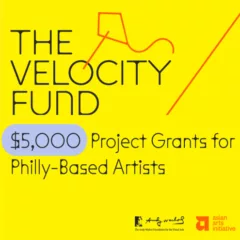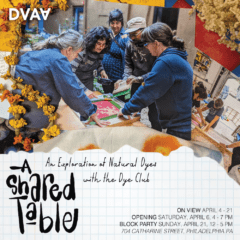There’s a fabulous piece of public art–a video projected on a window on Vine Street–good enough to make you slow down your car and forget to drive it.
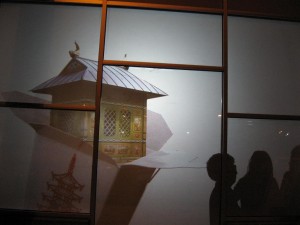
Nadia Hironaka’s Strange Stories from a Chinese Studio, is visible only after dark, on the window of the Asian Arts Initiative, 1219 Vine Street. It is part of Asian Arts’ second Chinatown In/flux exhibition, this one subtitled Future Landscapes. This outing, there are four (or six, depending on who’s counting–two of them are matched pairs of a sort) public art projects scattered around the Chinatown neighborhood.
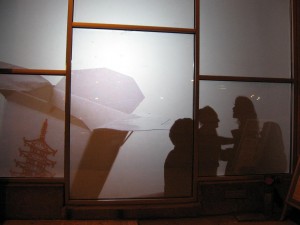
Hironaka’s piece celebrates the Asian presence in America and the cross-fertilization of the two cultures–American Pop billboard meets spare Asian crockery decoration. The video is like watching 1000 clowns emerge from a VW bug. A giant hand uses chopsticks to pick Asian cultural icons out of a Chinese food take-out container while Western cultural icons rain down from off camera (at least that’s where I came in on the video loop). The symbolic cultural exchange ranges from Heinz ketchup bottles to mah jongg tiles, and the logic magically shifts so what rains down or emerges from the box can be Asian or American. Off to the side, a group of ambiguous, silhouetted figures group, ungroup, regroup–people too flat to reveal their ethnic identities (unless you happen to know who’s who).
The image is luminous, beautiful and endlessly pleasing and engaging. It can deliver a quick hit for people driving by yet a slow unfolding of ideas for anyone who slows down to watch.
The other pieces in the exhibit are:
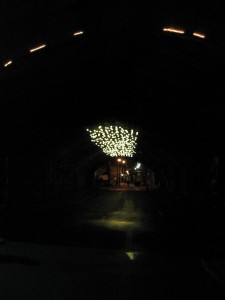
the little red string is a group of paper lanterns illuminating the archway under the old Reading Railroad viaduct at Carlton Street, between 11th and 12th. I bumped into the artists, Jonathan and Kimberly Stemler, the night I was trying to follow my Chinatown In/flux map, and they drove me to their installation. The lanterns celebrate the expansion of Chinatown north of Vine Street. This is right across the street from Where Vox, Copy and Tiger Strikes Asteroid galleries are located, but I didn’t notice the lights when I walked out the door there Friday night. I must have been studying my toes, because it is visible, and it does make the otherwise invisible archway of the viaduct have a noir presence at night. Hey, who doesn’t like lights? But I say, let’s get more of them and go for broke.
Just like Hironaka and the Stemler pieces are only good at night, the other two are really for daytime.
Chinatown Orange–one of the multi-part pieces–is first of all a parking lot at 10th and Vine coated with Glidden’s Chinatown Orange paint. There’s related work at the AAI. Since I was walking around at night, I couldn’t see the orange paint on the lot, nor was I able to find any signs in the dark.
I learned this from Sean Stoops, who oversaw the installation process:
We have a temp. sign on the fence west of the lot. The outdoor
painting was completed last weekend as an art happening. We are negotiating with the lot owners about more permanent signage thru August.
The artists, Kikuchi + Liu, are marking the site where the future Chinatown Community Center will rise. Unless you’re in on that and understand the paint color choice, the work is quite mysterious.
The piece Visionary Sightseeing Binoculars, by Rebecca Hackemann, overlooks the Vine Street Expressway at 10th and 12th streets (that’s two versions of the binoculars). Instead of viewing the Statue of Liberty when you gaze in, by turning a crank you get to see small stereoscopic drawings by children as well as other kinds of images of Chinatown past and plans envisioning Chinatown future (and specifically the expressway). I always like interactive cranks and stereoscopes, and I like that I could almost see well enough even at night, thanks to the lights of the cars on the expressway. However, drawings are a come-down from the promise of a telescopic view.
So seeing all four pieces at once is impossible, but it’s up until Aug. 2, 2009, so you have plenty of time to go once by day, once by night. For a map of where to find the art, stop by Asian Arts Initiative.




